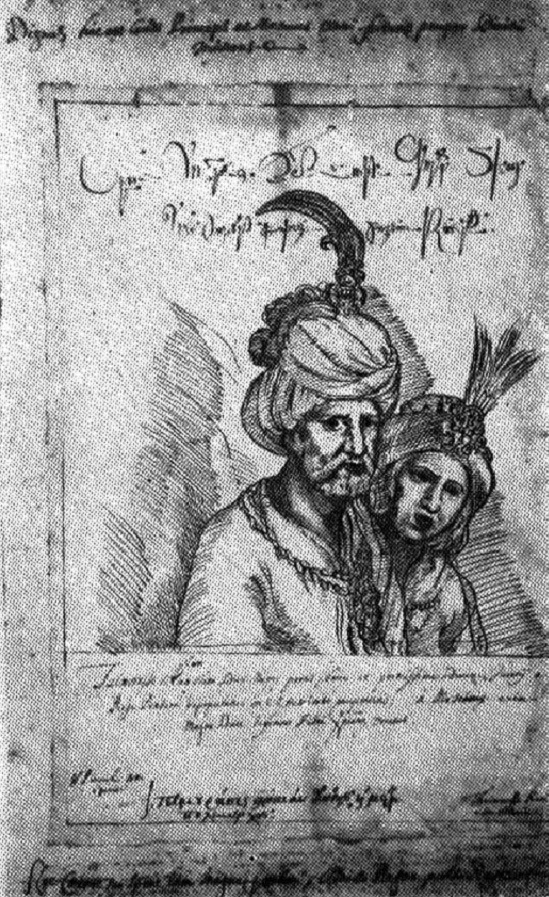|
Andronikashvili
The House of Andronikashvili ( ka, бғҗбғңбғ“бғ бғқбғңбғҳбғҷбғҗбғЁбғ•бғҳбғҡбғ”бғ‘бғҳ), sometimes known as Endronikashvili (бғ”бғңбғ“бғ бғқбғңбғҳбғҷбғҗбғЁбғ•бғҳбғҡбғ”бғ‘бғҳ), was a countly family in Georgia who claimed descent from emperor Andronicos I of the Eastern Roman Empire and played a prominent role in political, military and religious life of Georgia. After the Russian annexation of Georgia (1801), the Andronikashvili were confirmed in the dignity of knyaz Andronikov () in 1826. Origin The surname Andronikashvili, meaning "children escendantsof Andronikos", is attested in sixteenth-century documents, but oral tradition has it that the family descends from Alexios Komnenos (c. 1170вҖ“1199), the illegitimate son of the Eastern Roman emperor Andronikos I Komnenos (ruled 1183-1185) by his mistress and relative Theodora Komnene, Queen Dowager of Jerusalem. After the deposition and brutal murder of emperor Andronikos, Alexios is said to have taken refuge at the court of his ... [...More Info...] [...Related Items...] OR: [Wikipedia] [Google] [Baidu] |
Alastaneli
Alastaneli ( ka, бғҗбғҡбғҗбғЎбғўбғҗбғңбғ”бғҡбғҳ, "of/from Alastani") was a title of the Georgian dynastic princes ruling over the province of Javakheti from their castle at Alastani in the 13th and 14th centuries. According to traditional Georgian genealogy, this dynasty was a branch of the royal house of Bagrationi, stemming from King David VIII of Georgia (died 1311). Their status of "provincial kings" was rooted in the political fragmentation of the centralized Georgian monarchy under the Mongol hegemony. This line became extinct in the early 15th century. History Alastani, north of modern-day town of Akhalkalaki, became a centre of the domain of crown princes of Georgia early in the 13th century. Lasha-George, son of Queen Tamar the Great and the future king George IV of Georgia, is thought to have been the first in possession of this principality. The line of Alastani was founded by David VIII, who withdrew in Javakheti in 1302 after losing struggle for the Georgian thro ... [...More Info...] [...Related Items...] OR: [Wikipedia] [Google] [Baidu] |
Alexios Komnenos (son Of Andronikos I)
Alexios Komnenos ( 1170 вҖ“ 1199) was a natural son of Andronikos I Komnenos, the Byzantine Emperor ( r. 1183 вҖ“ 1185) by his relative and mistress Theodora Komnene, Queen Dowager of Jerusalem. During the reign of Emperor Manuel I Komnenos (r. 1143вҖ“1180), Alexios accompanied his father Andronikos in exile, visiting, inter alia, the Kingdom of Georgia. The Georgian king George III, their relative, granted to Andronikos several castles in Kakhetia in the east of Georgia. Andronikos returned to Constantinople and usurped the Byzantine crown in 1183, only to be overthrown and killed in 1185. Alexios then fled to Georgia, where he was restored to his father's Georgian estates. At one point, he was even considered by some Georgian nobles as a candidate to become a consort of the queen regnant Tamar of Georgia. According to the Georgian historical tradition, during Andronikos I's sojourn in Georgia, he left progeny in the country, which flourished and produced the noble family of An ... [...More Info...] [...Related Items...] OR: [Wikipedia] [Google] [Baidu] |
Erekle II
Heraclius II, also known as Erekle II ( ka, бғ”бғ бғ”бғҷбғҡбғ” II) and The Little Kakhetian ( ka, бғһбғҗбғўбғҗбғ бғҗ бғҷбғҗбғ®бғҳ, link=no ; 7 November 1720 or 7 October 1721 Cyril_Toumanoff.html" ;"title="ccording to Cyril Toumanoff">C. ToumanoffвҖ“ 11 January 1798), of the Bagrationi dynasty, was the List of monarchs of Georgia, king (''mepe'') of the Kingdom of Kakheti from 1744 to 1762, and of the Kingdom of Kartli-Kakheti from 1762 until his death in 1798. In the contemporary Persian sources he is referred to as Erekli Khan (), while Russians knew him as Irakly (). Heraclius is the Latinized form of his name. From being granted the kingship of Kakheti by his overlord Nader Shah in 1744 as a reward for his loyalty,Ronald Grigor Suny"The Making of the Georgian Nation"Indiana University Press, 1994. p 55 to becoming the penultimate king of the united kingdoms of Kakheti and Kartli in eastern Georgia, his reign is regarded as the swan song of the Georgian monarchy. Aided by ... [...More Info...] [...Related Items...] OR: [Wikipedia] [Google] [Baidu] |
Andronikos I Komnenos
Andronikos I Komnenos (; вҖ“ 12 September 1185), Latinized as Andronicus I Comnenus, was Byzantine emperor from 1183 to 1185. A nephew of John II Komnenos (1118вҖ“1143), Andronikos rose to fame in the reign of his cousin Manuel I Komnenos (1143вҖ“1180), during which his life was marked by political failures, adventures, scandalous romances, and rivalry with the emperor. After Manuel's death in 1180, the elderly Andronikos rose to prominence as the accession of the young Alexios II Komnenos led to power struggles in Constantinople. In 1182, Andronikos seized power in the capital, ostensibly as a guardian of the young emperor. Andronikos swiftly and ruthlessly eliminated his political rivals, including Alexios II's mother and regent, Maria of Antioch. In September 1183, Andronikos was crowned as co-emperor and had Alexios murdered, assuming power in his own name. Andronikos staunchly opposed the powerful Byzantine aristocracy and enacted brutal measures to curb their in ... [...More Info...] [...Related Items...] OR: [Wikipedia] [Google] [Baidu] |
Bagrationi Dynasty
The Bagrationi dynasty (; ) is a royal family, royal dynasty which reigned in Georgia (country), Georgia from the Middle Ages until the early 19th century, being among the oldest extant Christianity, Christian ruling dynasties in the world. In modern usage, the name of the dynasty is sometimes Hellenization, Hellenized and referred to as the Georgian Bagratids, also known in English as the Bagrations. The #Origins, origins of the dynasty are disputed. The early Georgian Bagratids gained the Principality of Iberia through Royal intermarriage, dynastic marriage after succeeding the Chosroid dynasty at the end of the 8th century. In 888 Adarnase IV of Iberia restored the Georgian monarchy; various Unification of the Georgian realm, native polities then united into the Kingdom of Georgia, which prospered from the 11th to the 13th century. This period of time, particularly the reigns of David IV of Georgia, David IV the Builder (1089вҖ“1125) and of his great-granddaughter Tamar of Ge ... [...More Info...] [...Related Items...] OR: [Wikipedia] [Google] [Baidu] |
Cholokashvili
The House of Cholokashvili ( ka, бғ©бғқбғҡбғқбғ§бғҗбғЁбғ•бғҳбғҡбғҳ, Russian: Р§РҫР»РҫРәР°РөРІСӢ) was an old Georgian noble family. It claimed an exotic foreign lineage and first appeared in the eastern Georgian province, and later kingdom, of Kakheti in 1320. They were enfeoffed of the office of Prince-Master of the Palace of Kakheti and produced several notable members from the 16th century into the 20th. History Traditional genealogical accounts have it that the family's ancestor was a Genoese officer who moved, in the 14th century, from a Crimean colony to Dagestan where he was dubbed by locals as ''Cholagh'' "for the multitude of sheep and cattle he possessed". Cholagh is said to have quarreled with the local tribesmen and fled into neighboring Georgia through the Derbend road in 1320. King George V of Georgia welcomed Cholagh and granted him an apanage and the princely title of the extinct family of Irubakidze in Kakheti. бғҳбғқбғҗбғңбғ” бғ‘бғҗбғўбғқбғңбғҳбғЁбғ•бғҳбғҡбғҳ ... [...More Info...] [...Related Items...] OR: [Wikipedia] [Google] [Baidu] |
Abashidze
The House of Abashidze ( ka, бғҗбғ‘бғҗбғЁбғҳбғ«бғ”) is a Nobility of Georgia (country), Georgian noble family and a former List of Georgian princely families#A, Georgian princely house. Appearing in the 15th century, they achieved prominence in the Kingdom of Imereti in western Georgia in the late 17th century and branched out in the Eastern Georgia (country), eastern Georgian kingdoms of Kakheti and Kartli as well as the then-Ottoman Empire, Ottoman-held southwestern region of Adjara. After the Russian Empire, Russian annexation of Georgian polities, the family was confirmed as Knyaz Abashidze () by the TsarвҖҷs decree of 1825. History The Abashidze family possibly derived from the medieval Georgian noble house of Liparitids, Liparitid-Orbeliani, but the family legend holds that it descended from an Ethiopia, AbyssinianIoane Bagrationi, Bagrationi, Ioane (1768-1830)Abashidze ''The Brief Description of the Georgian Noble Houses''. Retrieved on January 16, 2010 officer named Aba ... [...More Info...] [...Related Items...] OR: [Wikipedia] [Google] [Baidu] |
Grandee
Grandee (; , ) is an official royal and noble ranks, aristocratic title conferred on some Spanish nobility. Holders of this dignity enjoyed similar privileges to those of the peerage of France during the , though in neither country did they have the significant constitutional political role the House of Lords gave to the Peerage of England, of Peerage of Great Britain, Great Britain and of the Peerage of the United Kingdom, United Kingdom. A "grandee of Spain" nonetheless enjoyed greater social privileges than those of other similar European dignities. With the exception of Duke of Fernandina, Fernandina, List of dukes in the peerage of Spain, all Spanish dukedoms are automatically attached to a grandeeship, yet only a few marquessates, Count (title), countships, List of viscounts in the peerage of Spain, viscountcies, List of barons in the peerage of Spain, baronies and List of lords in the peerage of Spain, lordships have the distinction. A single person can be a grandee of S ... [...More Info...] [...Related Items...] OR: [Wikipedia] [Google] [Baidu] |
Kingdom Of Kakheti
The Kingdom of Kakheti ( ka, бғҷбғҗбғ®бғ”бғ—бғҳбғЎ бғЎбғҗбғӣбғ”бғӨбғқ, tr; also spelled ''Kaxet'i'' or ''Kakhetia'') was a late medieval and early modern monarchy in eastern Georgia, centered at the province of Kakheti, with its capital first at Gremi and then at Telavi. It emerged in the process of a tripartite division of the Kingdom of Georgia in 1465 and existed, with several brief intermissions, until 1762 when Kakheti and the neighboring Georgian kingdom of Kartli were merged through a dynastic succession under the Kakhetian branch of the Bagrationi dynasty. Through much of this period, the kingdom was a vassal of the successive dynasties of Iran, and to a much shorter period Ottoman Empire, but enjoyed intermittent periods of greater independence, especially after 1747. Early history A previous Kingdom of Kakheti was created in the 8th century following the successful rebellion of the mountainous tribes of Tzanaria, which freed a large part of Georgia from Arab cont ... [...More Info...] [...Related Items...] OR: [Wikipedia] [Google] [Baidu] |
Gerb Andronikovii
GERB, an acronym for Citizens for European Development of Bulgaria (), is a Conservatism, conservative center-right Populism, populist List of political parties in Bulgaria, political party which was the ruling party of Bulgaria during the periods between 2009вҖ“2013, 2014-2021, 2025-present and was supporting the Denkov Government, Denkov government between 2023-2024. History GERB is headed by former Prime Minister of Bulgaria Boyko Borisov, the former List of mayors of Sofia, mayor of Sofia, former member of the National Movement Simeon II and former personal guard of Todor Zhivkov in the 1990s. The establishment of the party followed the creation of a non-profit organization with the acronym (in Bulgarian) GERB вҖ” ''Citizens for European Development of Bulgaria'', earlier the same year. In early January 2007, and early February 2007, the party came second in opinion poll, public polls on party support with around 14%, trailing the Bulgarian Socialist Party which had ... [...More Info...] [...Related Items...] OR: [Wikipedia] [Google] [Baidu] |




